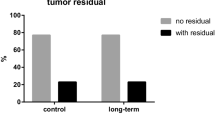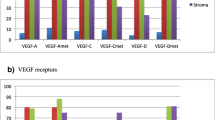Abstract
Purpose
For patients with epithelial ovarian cancer (EOC) cytoreduction, with a combination of taxane and platinum, is the standard of care. Despite this, approximately 50% of patients with advanced disease will relapse and moreover 15–20% of cases of EOC are resistant to platinum based chemotherapy. Vascular Endothelial Growth Factor (VEGF), an angiogenic factor, is associated with poor prognosis. This study was undertaken to examine whether there is an association between VEGF-A expression in the tumour of EOC patients and their response to platinum based chemotherapy.
Methods
The study cohort consisted of 66 patients with advanced stage EOC (FIGO III-IV). Ovarian cancer tissue was analysed for VEGF-A expression immunohistochemically. Protein expression was measured and correlated, with platinum sensitivity and overall patient survival.
Results
Median age of patients was 53 years, 45 patients had platinum sensitive disease (68%), the remaining patients being platinum resistant (32%). Of the platinum resistant group, 18 (86%) patients had high VEGF score compared to only 1 (2%) with high VEGF score in the platinum sensitive group. Median survival was 11 months in the patient group with high VEGF score versus 32 months in that cohort with low VEGF score. VEGF expression was significantly inversely correlated with overall survival (P < 0.0001).
Conclusion
We demonstrated that tumours of patients with platinum resistant EOC exhibit higher levels of VEGF expression compared to the platinum sensitive group. VEGF in EOC, may be of clinical and therapeutic relevance and suggests a role for first line anti-angiogenic therapy.


Similar content being viewed by others
References
Berek J (2005) Epithelial ovarian cancer. In: Berek J (ed) Practical gynecolgical oncology, vol 4. Lippincott Wiliams and Wilkins, Philadelphia
Friedlander ML (1998) Prognostic factors in ovarian cancer. Semin Oncol 25(3):305–314
Duncan TJ, Al-Attar A, Rolland P, Scott IV, Deen S, Liu DT et al (2008) Vascular endothelial growth factor expression in ovarian cancer: a model for targeted use of novel therapies? Clin Cancer Res 14(10):3030–3035
Battegay EJ (1995) Angiogenesis: mechanistic insights, neovascular diseases, and therapeutic prospects. J Mol Med 73(7):333–346
Boxer GM, Tsiompanou E, Levine T, Watson R, Begent RH (2005) Immunohistochemical expression of vascular endothelial growth factor and microvessel counting as prognostic indicators in node-negative colorectal cancer. Tumour Biol 26(1):1–8
Folkman J (1995) Angiogenesis in cancer, vascular, rheumatoid and other disease. Nat Med 1(1):27–31
Fujimoto J, Sakaguchi H, Hirose R, Ichigo S, Tamaya T (1998) Biologic implications of the expression of vascular endothelial growth factor subtypes in ovarian carcinoma. Cancer 83(12):2528–2533
Berse B, Brown LF, Van de Water L, Dvorak HF, Senger DR (1992) Vascular permeability factor (vascular endothelial growth factor) gene is expressed differentially in normal tissues, macrophages, and tumors. Mol Biol Cell 3(2):211–220
Dang DT, Chun SY, Burkitt K, Abe M, Chen S, Havre P et al (2008) Hypoxia-inducible factor-1 target genes as indicators of tumor vessel response to vascular endothelial growth factor inhibition. Cancer Res 68(6):1872–1880
Caunt M, Mak J, Liang WC, Stawicki S, Pan Q, Tong RK et al (2008) Blocking neuropilin-2 function inhibits tumor cell metastasis. Cancer Cell 13(4):331–342
Neuhaus T, Pabst S, Stier S, Weber AA, Schror K, Sachinidis A et al (2004) Inhibition of the vascular-endothelial growth factor-induced intracellular signaling and mitogenesis of human endothelial cells by epigallocatechin-3 gallate. Eur J Pharmacol 483(2–3):223–227
Mylona E, Nomikos A, Alexandrou P, Giannopoulou I, Keramopoulos A, Nakopoulou L (2007) Lymphatic and blood vessel morphometry in invasive breast carcinomas: relation with proliferation and VEGF-C and -D proteins expression. Histol Histopathol 22(8):825–835
Roberts DL, Williams KJ, Cowen RL, Barathova M, Eustace AJ, Brittain-Dissont S et al (2009) Contribution of HIF-1 and drug penetrance to oxaliplatin resistance in hypoxic colorectal cancer cells. Br J Cancer 101(8):1290–1297
Jubb AM, Hurwitz HI, Bai W, Holmgren EB, Tobin P, Guerrero AS et al (2006) Impact of vascular endothelial growth factor-A expression, thrombospondin-2 expression, and microvessel density on the treatment effect of bevacizumab in metastatic colorectal cancer. J Clin Oncol 24(2):217–227
Yamamoto S, Konishi I, Tsuruta Y, Nanbu K, Mandai M, Kuroda H et al (1997) Expression of vascular endothelial growth factor (VEGF) during folliculogenesis and corpus luteum formation in the human ovary. Gynecol Endocrinol 11(6):371–381
Abu-Jawdeh GM, Faix JD, Niloff J, Tognazzi K, Manseau E, Dvorak HF et al (1996) Strong expression of vascular permeability factor (vascular endothelial growth factor) and its receptors in ovarian borderline and malignant neoplasms. Lab Invest 74(6):1105–1115
Byrne AT, Ross L, Holash J, Nakanishi M, Hu L, Hofmann JI et al (2003) Vascular endothelial growth factor-trap decreases tumor burden, inhibits ascites, and causes dramatic vascular remodeling in an ovarian cancer model. Clin Cancer Res 9(15):5721–5728
Markman M, Hoskins W (1992) Responses to salvage chemotherapy in ovarian cancer: a critical need for precise definitions of the treated population. J Clin Oncol 10(4):513–514
Alvarez AA, Krigman HR, Whitaker RS, Dodge RK, Rodriguez GC (1999) The prognostic significance of angiogenesis in epithelial ovarian carcinoma. Clin Cancer Res 5(3):587–591
Hollingsworth HC, Kohn EC, Steinberg SM, Rothenberg ML, Merino MJ (1995) Tumor angiogenesis in advanced stage ovarian carcinoma. Am J Pathol 147(1):33–41
Paley PJ, Staskus KA, Gebhard K, Mohanraj D, Twiggs LB, Carson LF et al (1997) Vascular endothelial growth factor expression in early stage ovarian carcinoma. Cancer 80(1):98–106
Gasparini G, Bonoldi E, Viale G, Verderio P, Boracchi P, Panizzoni GA et al (1996) Prognostic and predictive value of tumour angiogenesis in ovarian carcinomas. Int J Cancer 69(3):205–211
Yang JC, Haworth L, Sherry RM, Hwu P, Schwartzentruber DJ, Topalian SL et al (2003) A randomized trial of bevacizumab, an anti-vascular endothelial growth factor antibody, for metastatic renal cancer. N Engl J Med 349(5):427–434
Giantonio BJ, Catalano PJ, Meropol NJ, O’Dwyer PJ, Mitchell EP, Alberts SR et al (2007) Bevacizumab in combination with oxaliplatin, fluorouracil, and leucovorin (FOLFOX4) for previously treated metastatic colorectal cancer: results from the Eastern Cooperative Oncology Group Study E3200. J Clin Oncol 25(12):1539–1544
Cobleigh MA, Langmuir VK, Sledge GW, Miller KD, Haney L, Novotny WF et al (2003) A phase I/II dose-escalation trial of bevacizumab in previously treated metastatic breast cancer. Semin Oncol 30(5 Suppl 16):117–124
Cannistra SA, Matulonis UA, Penson RT, Hambleton J, Dupont J, Mackey H et al (2007) Phase II study of bevacizumab in patients with platinum-resistant ovarian cancer or peritoneal serous cancer. J Clin Oncol 25(33):5180–5186
Folkman J (2004) Endogenous angiogenesis inhibitors. Apmis 112(7–8):496–507
Engels K, du Bois A, Harter P, Fisseler-Eckhoff A, Kommoss F, Stauber R et al (2009) VEGF-A and i-NOS expression are prognostic factors in serous epithelial ovarian carcinomas after complete surgical resection. J Clin Pathol 62(5):448–454
Han ES, Monk BJ (2007) Bevacizumab in the treatment of ovarian cancer. Expert Rev Anticancer Ther 7(10):1339–1345
O’Toole SA, Sheppard BL, Laios A, O’Leary JJ, McGuinness EP, D’Arcy T et al (2007) Potential predictors of chemotherapy response in ovarian cancer–how do we define chemosensitivity? Gynecol Oncol 104(2):345–351
Hu L, Hofmann J, Holash J, Yancopoulos GD, Sood AK, Jaffe RB (2005) Vascular endothelial growth factor trap combined with paclitaxel strikingly inhibits tumor and ascites, prolonging survival in a human ovarian cancer model. Clin Cancer Res 11(19 Pt 1):6966–6971
Bamias A, Koutsoukou V, Terpos E, Tsiatas ML, Liakos C, Tsitsilonis O et al (2008) Correlation of NK T-like CD3 + CD56 + cells and CD4 + CD25 + (hi) regulatory T cells with VEGF and TNFalpha in ascites from advanced ovarian cancer: association with platinum resistance and prognosis in patients receiving first-line, platinum-based chemotherapy. Gynecol Oncol 108(2):421–427
Burger RA, Sill MW, Monk BJ, Greer BE, Sorosky JI (2007) Phase II trial of bevacizumab in persistent or recurrent epithelial ovarian cancer or primary peritoneal cancer: a Gynecologic Oncology Group Study. J Clin Oncol 25(33):5165–5171
Raspollini MR, Amunni G, Villanucci A, Baroni G, Boddi V, Taddei GL (2004) Prognostic significance of microvessel density and vascular endothelial growth factor expression in advanced ovarian serous carcinoma. Int J Gynecol Cancer 14(5):815–823
Ferrara N, Gerber HP, LeCouter J (2003) The biology of VEGF and its receptors. Nat Med 9(6):669–676
Acknowledgment
Authors received grand support from Cancer Research UK (G. M. B, R. H. J. B) Programme Grant C34-A5149 and Experimental Cancer Medicine Centre (ECMC) (G. M. B, M. R, R. H. J. B). This work was undertaken at UCL, who secured a proportion of funding from the Department of Health–National Institute of Health Research Biomedical Research Centre Funding Scheme.
Author information
Authors and Affiliations
Corresponding author
Rights and permissions
About this article
Cite this article
Siddiqui, G.K., Maclean, A.B., Elmasry, K. et al. Immunohistochemical expression of VEGF predicts response to platinum based chemotherapy in patients with epithelial ovarian cancer. Angiogenesis 14, 155–161 (2011). https://doi.org/10.1007/s10456-010-9199-4
Received:
Accepted:
Published:
Issue Date:
DOI: https://doi.org/10.1007/s10456-010-9199-4




